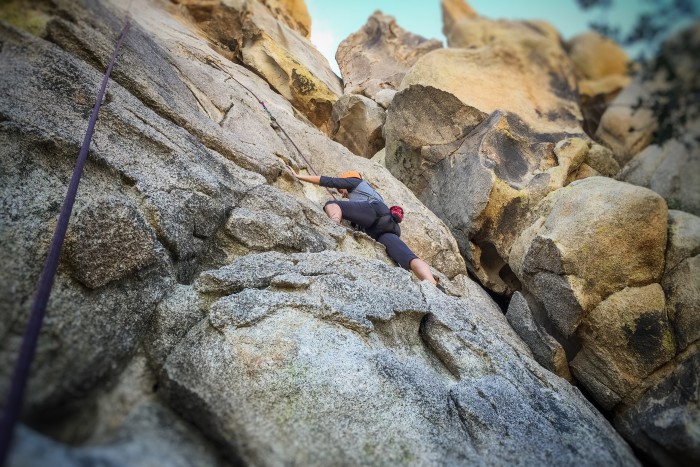Transitioning from climbing indoors to outdoors can often be difficult. There’s not enough information given to a new climber when starting off. Some go to an indoor gym to try climbing for the first time while others take outdoor courses or get out there with the friend who has gear and some experience. Truth is there’s not a set rule on whether you should start indoors or outdoors, but it is important to understand there are big differences between the two.

Some differences between indoor and outdoor climbing
| Indoors | Outdoors |
| gyms have colorful holds and difficulty level which make picking and finding your route very simple | there are no colorful holds to follow and in most cases you can find route information in a guidebook |
| gyms have rental equipment (harness, shoes, chalk-bags, belay devices) and climbing ropes | you need to have all your equipment |
| gyms have convenient shade and routes are accessible within a few feet | you may or may not find shade and wall approach may vary from 1 minute to 2.5 hours+ |
| lead walls have fixed quick-draws that are normally 5 to 10 feet apart | you need to have your own set of quickdraws and bolt distance can range from 5 to 20+ feet apart |
Pros about indoor climbing
convenience, short approach, can be done at night, good for training routines, weather is never an issue
Cons about indoor climbing
is not real rock, you get used to following color patterns
Pros about outdoor climbing
convenient, short approach in many cases, your are outdoors on real rock, good for training
Cons about outdoor climbing
long approach in some cases, can take more time to prepare and set up, can be difficult to do at night, depend on good weather conditions

Some common misconceptions about indoor and outdoor climbing
| Indoors | Outdoors |
| climbing is easier, less frightening and is better for beginners | climbing is harder, more frightening is harder for beginners |
| is where every climbing should start | is where all experienced climbers should go |
| is more affordable | is more costly |
So let’s talk about these common misconceptions in more detail…
Some may consider climbing indoors easier and less frightening because you’re dealing with plastic holds and fake walls, but someone can easily get hurt in an indoor gym just as they would outdoors. Climbing outdoors can be more challenging for some because you’re dealing with real rock, which can make a person automatically assume they are going to get hurt if they make a mistake. When you’re climbing indoors usually the routes are set to a specific level and in most cases is consistent throughout the entire route. When outdoors, the level of difficulty on a route is determined by the hardest move. So let’s say we have a 5.10 route with 1 difficult problem (which is often called the crux). Whatever the level of that hardest problem, is what the route will be rated. The rest of the route is easier than the 1 problem. An outdoor route can have a sequence of 5.6 moves, but if it has 1 hard problem that is rated 5.9, then that is what the entire route is rated. The highest level of 1 problem will determine the rating on the route.
There’s no rule or regulation that stipulates whether a beginner should start climbing indoors or outdoors, that should be based on convenience. Either can be a great start for anyone. Both places offer a variety of options for beginners, such as; instruction, information on gear and equipment.
Climbing indoors is not necessarily more or less expensive than climbing outdoors
Let’s take for example:
- a person pays $50 month for a gym membership, multiply that by 12 month and the total cost is $600 for one year. That is assuming the this particular gym is going to teach you all the fundamentals you need to learn to do indoor rope climbing for free.
- a person pays $200 for a beginner class to learn rope climbing, another $200-$300 buying gear (rope, shoes, harness, belay device), and still have a spear $100-$200 they can use to take an anchor building course and not have to depend on someone else to set up top ropes for them outdoors. The skills you learn will stay with you for many years and so will the gear, before you need to replace it.
The amount of money that you’re going to spend really depends on how much climbing you want to do
If you’re just going to climb once every blue moon, because you may have other commitments or your job may not allow enough time, then indoor climbing or buying an outdoor guided trip would be the most cost effective and convenient way to go.
If you decide to pick up climbing as a hobby, and want to or can commit more of your time to the sport, then it would be more cost effective to get the proper training courses and the proper gear.
I hope some of this information was helpful. Regardless of what you chose, climbing is an awesome and fun way to stay in tip top shape. If you haven’t tried it before, I highly recommend you give it a shot and let a professional take you out for an adventure.
So now answer this…
